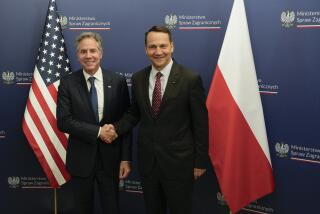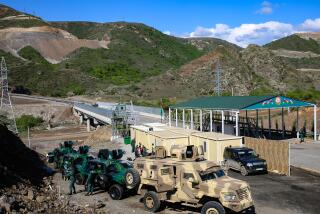Focus on Further Arms Cuts Urged : Disarmament: Anticipating agreement on a 50% cut in nuclear warheads, U.S. and Soviet conferees set their sights on âa minimum nuclear deterrent.â
MOSCOW â Looking beyond the current negotiations to reduce strategic and conventional armaments, a top-level conference of American and Soviet lawyers, including former arms negotiators for both countries, urged their governments Monday to begin considering the next stages of arms control.
Anticipating a 50% reduction in nuclear warheads held by the superpowers, the conference endorsed as a negotiating goal a further 50% cut to about 3,000 warheads each, with the next step a basic âminimum nuclear deterrentâ of perhaps as few as 600 each.
âWe are getting close enough to these major, present-day arms control goals that we should think quite seriously about what comes next,â Stanley R. Resor, former secretary of the army and undersecretary of defense, said at the conclusion of the weeklong conference between the Assn. of Soviet Lawyers and the Boston-based Lawyers Alliance for Nuclear Arms Control.
âGoals for the future should give some political impetus to complete in the next year the negotiations that are now under way--a feeling of momentum--and they should provide both sides with the conceptual framework of how to continue the process of arms reduction over the next decade, the next two or even three decades,â Resor said.
The conferenceâs proposals are expected to have an impact on both governments as they do their long-term planning. Each delegation includes senior members of previous negotiations, and the recommendations of past conferences became the basis for present negotiations.
âOur most important function is to think ahead,â said George Bunn, the first general counsel to the U.S. Arms Control and Disarmament Agency and now a fellow at Stanford Universityâs Center for International Security and Control. âOur own government was not thinking beyond the present effort to get a strategic arms reduction treaty, its negotiation and its drafting, and we have heard here that neither was the Soviet.
âThese proposals can help progress by starting the process of thinking about where we go next, and without thinking about that we might not even get to where we think we want to go now.â
Moscow and Washington both hope that their negotiators will reach agreement on the first strategic arms reduction treaty in time for the summit meeting next spring in Washington between President Bush and President Mikhail S. Gorbachev.
They also expect that an agreement will be reached by the end of next year between the North Atlantic Treaty Organization and the Warsaw Pact powers on conventional armed forces in Central Europe, opening the way to the reduction of tactical nuclear weapons deployed in Europe and then to subsequent cutbacks in the huge standing armies of Europe.
âCuts in strategic offensive weapons in excess of 50% is not science fiction, not an illusion nor an impossibility today,â Vadim Sobakin, vice president of the Assn. of Soviet Lawyers and an official of the Communist Partyâs Central Committee, said. âIt is a realistic issue that we may now consider.
âWe have agreed on the need to discuss with our American partners prospects for deep cuts in strategic offensive arms within the framework of âminimum nuclear deterrence.â But unlike some of our American colleagues, we see this as a step toward a nuclear-free world, something we do not regard as utopian and unobtainable.â
The next step, according to the conference proposal, should be U.S.-Soviet negotiations over the next decade for âdeep cutsâ of a further 50% in their strategic arsenals starting in the year 2000.
These would be followed by negotiations for the âminimum nuclear deterrent,â a new concept that the conference said should not focus on the number of nuclear warheads each side would hold but on the entire relationship between the superpowers.
The heart of this agreement, which might not be concluded for 20 years and would require perhaps another 15 years to implement, would be confidence-building measures and verification procedures sufficient to persuade the United States and the Soviet Union that their security was assured with fewer and fewer weapons.
The basic principles of the agreement would retain sufficient retaliatory forces so that there would no incentive for a preemptive first strike; would prohibit strategic defenses against missile attack, and would provide for adequate verification of all aspects of the agreement.
But the conference warned that a major obstacle to such a treaty would be the nuclear arsenals of other countries--not only those of Britain, China and France but also those of Israel, India, Pakistan and other countries with the potential to develop nuclear weapons.
âIf the United States and the Soviet Union are to achieve a minimum deterrent,â the conference said, âother governments must be persuaded to join the process soon--to freeze and reduce nuclear arsenals that already exist and to restrain the further spread of nuclear weapons.â
The conference recommended bilateral negotiations to end production of nuclear material for weapons and its transfer to peaceful uses; a comprehensive ban on nuclear testing to halt the development of new nuclear weapons, and a continued moratorium on the testing of anti-satellite weapons to prevent a new stage in the superpower arms race.
Among other American participants were Ralph Earle II, chief negotiator in the SALT II arms talks; John B. Rhinelander, legal adviser to the U.S. team in the SALT I negotiations; Shirley M. Hufstedler, former secretary of education; Erwin N. Griswold, former solicitor general, and Leonard M. Marks, one of the Watergate prosecutors.
Soviet participants included Maj. Gen. Geli Batenin, a Communist Party Central Committee official; Sergei Batsanov, a representative to the U.N. Disarmament Conference; Adm. Nikolai Amelko, former deputy chief of the General Staff and now a Foreign Ministry specialist on arms control, and Maj. Gen. Boris Surikov, military adviser to Soviet negotiators in SALT I.
BACKGROUND
Major obstacles to reaching agreement on a strategic arms reduction treaty apparently have been removed, and President Bush and Soviet President Mikhail S. Gorbachev are expected to sign an agreement at their summit meeting in mid-1990. The way was cleared for the pact when Moscow eased its opposition to the U.S. âStar Warsâ program. The treaty, as envisioned at this time, would cut U.S. and Soviet intercontinental ballistic missile arsenals in half.
More to Read
Sign up for Essential California
The most important California stories and recommendations in your inbox every morning.
You may occasionally receive promotional content from the Los Angeles Times.










